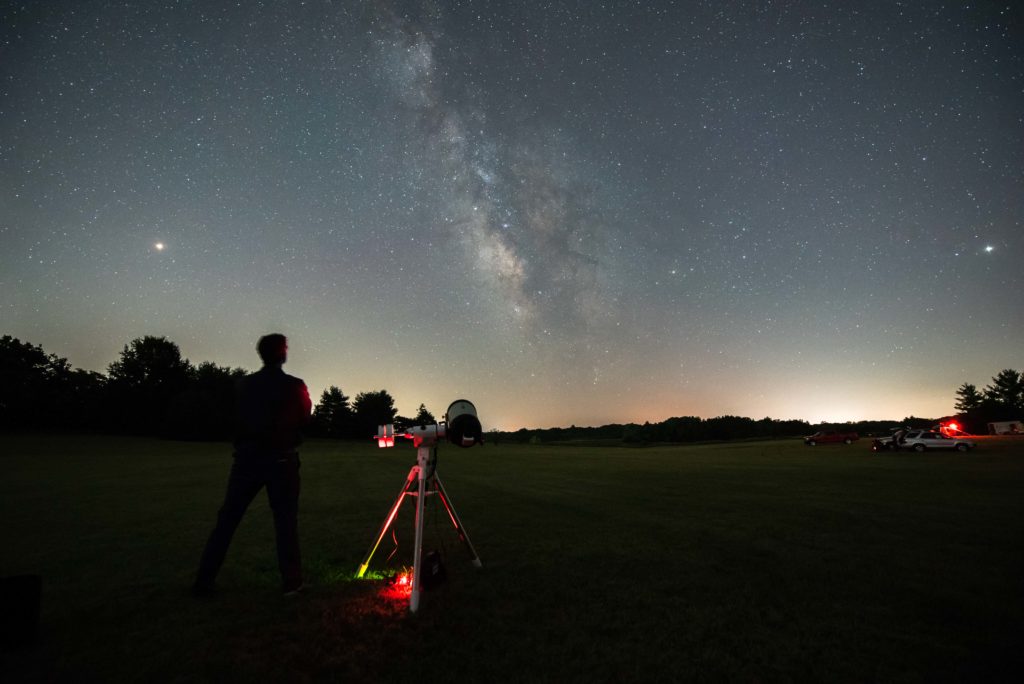
How to Choose Binoculars and Telescopes for Astronomy
Nearly every wants to get a new telescope or pair of binoculars... or both. Binoculars will show tens of thousands of stars and many dozens of bright “deep-sky” objects like star clusters, nebulae, and galaxies. And even a simple backyard telescope reveals thousands of fascinating objects… enough for a lifetime of pleasant observation and thoughtful contemplation.
Choosing binoculars or a telescope, however, is a big challenge for beginner amateur astronomers. There are hundreds of models available with all sorts of bewildering specifications and features. Many beginners end up choosing instruments that are too big, too complicated, or of too poor quality to be useful. And many end up becoming frustrated with stargazing and give up.
That’s not going to happen to you.
That’s because this free course will show you the basics of choosing a beginner’s telescope and a good pair of binoculars for visual observation of the night sky. With this know-how, you’ll be able to choose the right stargazing tools for your budget and personal situation, tools that will let you see thousands of beautiful and memorable celestial objects that few people ever get to see. And you get, in the last lesson, five recommendations for the best telescopes for beginning amateur astronomers.
Lesson 1 – The True Purpose of a Telescope
Some beginners think magnification is the key specification of a telescope (or binoculars). Many junk telescopes – the kind sold in department stores, sporting-good stores, and in camera stores that should know better – are marketed on the basis of ridiculously high magnification. But this first lesson of choosing a telescope explains the much simpler purpose of a telescope: to collect light.
Lesson 2 – How to Choose Astronomy Binoculars
Every stargazer, beginner or expert, needs at least one good pair of binoculars. In this lesson you learn the key specifications of binoculars and what to look for when you choose a pair of binoculars for astronomy.

Lesson 3 – What to Know Before You Buy a Telescope
The worst (first) thing a new stargazer can do is run off and buy a telescope without knowing the first thing about astronomy. In the previous lesson, you learned that binoculars should come before a telescope. But there’s more to know and understand. Here are ten things to know before you starting planning your first telescope purchase.
Lesson 4 – The Five Numbers that Explain a Telescope
In their simplest terms, from the most basic beginner scope to the Hubble Space Telescope, all telescope share a few common features. This lesson explains them and how they can be summarized in five numbers.
Lesson 5 – Refractor Telescopes
They were the first type of telescope invented. But they’re still amazingly popular among visual observers and astrophotographers. They are refracting telescopes, the ones with a lens up top and an eyepiece down below. Here’s how they work and whether they are the right ‘first telescope’ for you.

Lesson 6 – Newtonian Reflectors and Dobsonians
Based on a design by Isaac Newton in the 17th century, Newtonian reflectors and they budget-friendly cousin, the Dobsonian, offer the biggest light-collecting bang for your buck. Here’s how they work and their pros and cons for visual astronomy.
Lesson 7 – Schmidt-Cassegrain Telescopes
Newtonian reflectors, covered in the last lesson, have one big drawback: they are big. But a hybrid telescope design – the Schmidt-Cassegrain – uses lenses and mirrors to compress the long length of a Newtonian tube into a much smaller optical tube that works as a ‘jack of all trades scope’.

Lesson 8 – Maksutov-Cassegrain Telescopes
Similar to Schmidt-Cassegrains, ‘Maks’ uses lenses and mirrors to pack a long focal length into a small package. These scopes are ideal for lunar and planetary observers looking to get crisp, high-magnification views and images.
Lesson 9 – Telescope Mounts
Every telescope sits on a mount that helps point it around the sky and keep it steady. Here’s a primer on the two types of telescope mount, alt-azimuth and equatorial, as well as the relatively new ‘go-to’ technology that makes life easier for all stargazers.
Lesson 10 – Recommended Telescopes for Beginning Stargazers (LINK TO COME)
Based on the previous lessons in this course, let’s look at five recommended telescopes that work well for beginning observers of all budgets and situations.
Other Resources
How to choose eyepieces for astronomical telescopes
How to See in the Dark
Video Series – Choosing Telescopes for Beginners